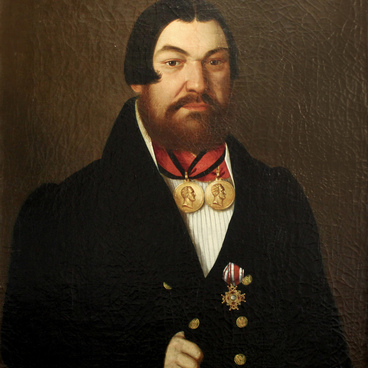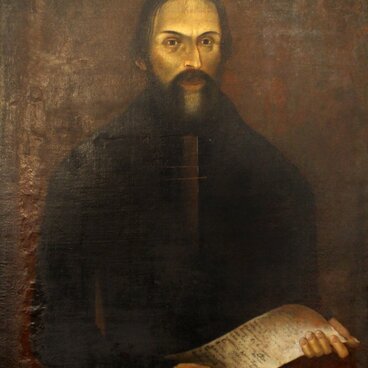The portrait of Anna Dorofeyeva is certainly one of the best child portraits in the urban painting of the first half of the 19th century. The artist is unknown.
Anna was born around 1841, and her image is likely to have been painted in the mid-19th century, which is also indicated by the style of her dress. The image of a dark-eyed maiden wearing a dark-blue dress and sitting in an upright chair is one of the most popular portraits of the Uglich Museum that has been displayed at several exhibitions and can be seen on souvenirs sold in the city. It is often referred to as “Girl with a Rose”: starting from the 18th century and for a long period after that, a half-blooming pale-pink flower was a typical attribute of portraits of teenage girls.
The child portrait of Anna Dorofeyeva entered the museum from the famous Old Believer chapel in Uglich with a well-known history. It was located in the large house of the merchants Ivan Vasilyevich and Mikhail Vasilyevich Vyzhilov near the city center. Apart from Anna’s portrait, there were also images of her parents, the Dorofeyev merchants, who later became related to the Vyzhilovs when Anna married Dmitry, the son of Mikhail.
The Vyzhilov brothers and their entourage were known in Uglich as faithful zealots of the old faith. They maintained a connection with the Old Believer centers in Moscow, and in the confession books of the local church, it was always mentioned that they were absent at the confession “due to the schism”. Dmitry’s parents got married independently in Moscow instead of going to church, and the Uglich priest made the following note near Mikhail’s name, “He lives with a girl called Minodora who allegedly married him under the Old Believer laws.”
There was not only a chapel in the merchant house but also a kind of a small monastery as well as a large library. After the revolution, several picturesque portraits were transferred from this house to the museum, along with etchings and numerous drawings inspired by religious subject matters and created by the Old Believer community. After the chapel was closed, the descendants of the Dorofeyevs and Vyzhilovs donated the old books kept in their families to the museum.
Anna was born around 1841, and her image is likely to have been painted in the mid-19th century, which is also indicated by the style of her dress. The image of a dark-eyed maiden wearing a dark-blue dress and sitting in an upright chair is one of the most popular portraits of the Uglich Museum that has been displayed at several exhibitions and can be seen on souvenirs sold in the city. It is often referred to as “Girl with a Rose”: starting from the 18th century and for a long period after that, a half-blooming pale-pink flower was a typical attribute of portraits of teenage girls.
The child portrait of Anna Dorofeyeva entered the museum from the famous Old Believer chapel in Uglich with a well-known history. It was located in the large house of the merchants Ivan Vasilyevich and Mikhail Vasilyevich Vyzhilov near the city center. Apart from Anna’s portrait, there were also images of her parents, the Dorofeyev merchants, who later became related to the Vyzhilovs when Anna married Dmitry, the son of Mikhail.
The Vyzhilov brothers and their entourage were known in Uglich as faithful zealots of the old faith. They maintained a connection with the Old Believer centers in Moscow, and in the confession books of the local church, it was always mentioned that they were absent at the confession “due to the schism”. Dmitry’s parents got married independently in Moscow instead of going to church, and the Uglich priest made the following note near Mikhail’s name, “He lives with a girl called Minodora who allegedly married him under the Old Believer laws.”
There was not only a chapel in the merchant house but also a kind of a small monastery as well as a large library. After the revolution, several picturesque portraits were transferred from this house to the museum, along with etchings and numerous drawings inspired by religious subject matters and created by the Old Believer community. After the chapel was closed, the descendants of the Dorofeyevs and Vyzhilovs donated the old books kept in their families to the museum.


